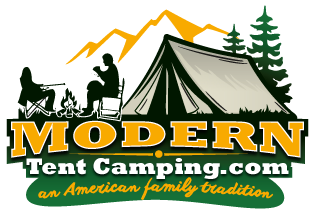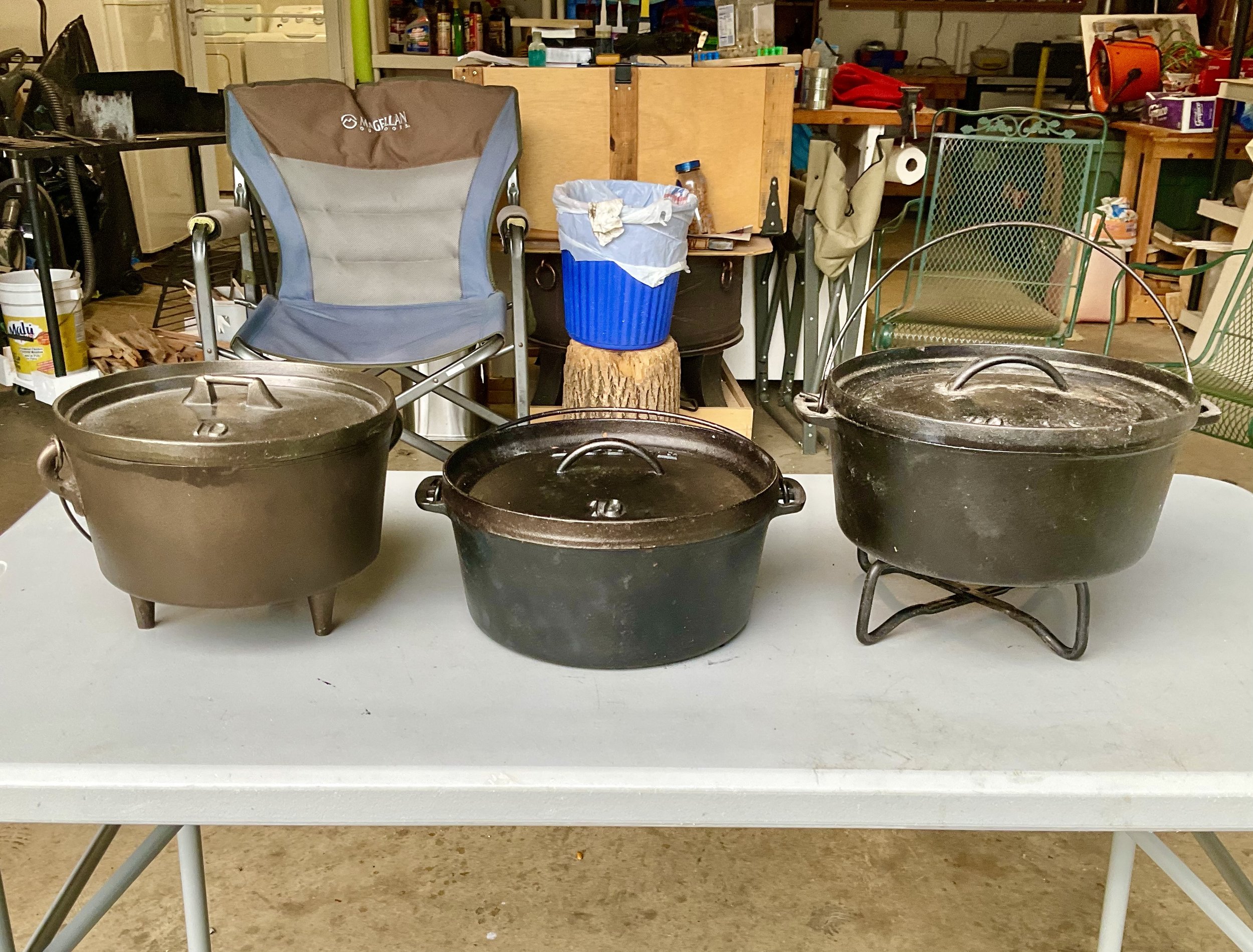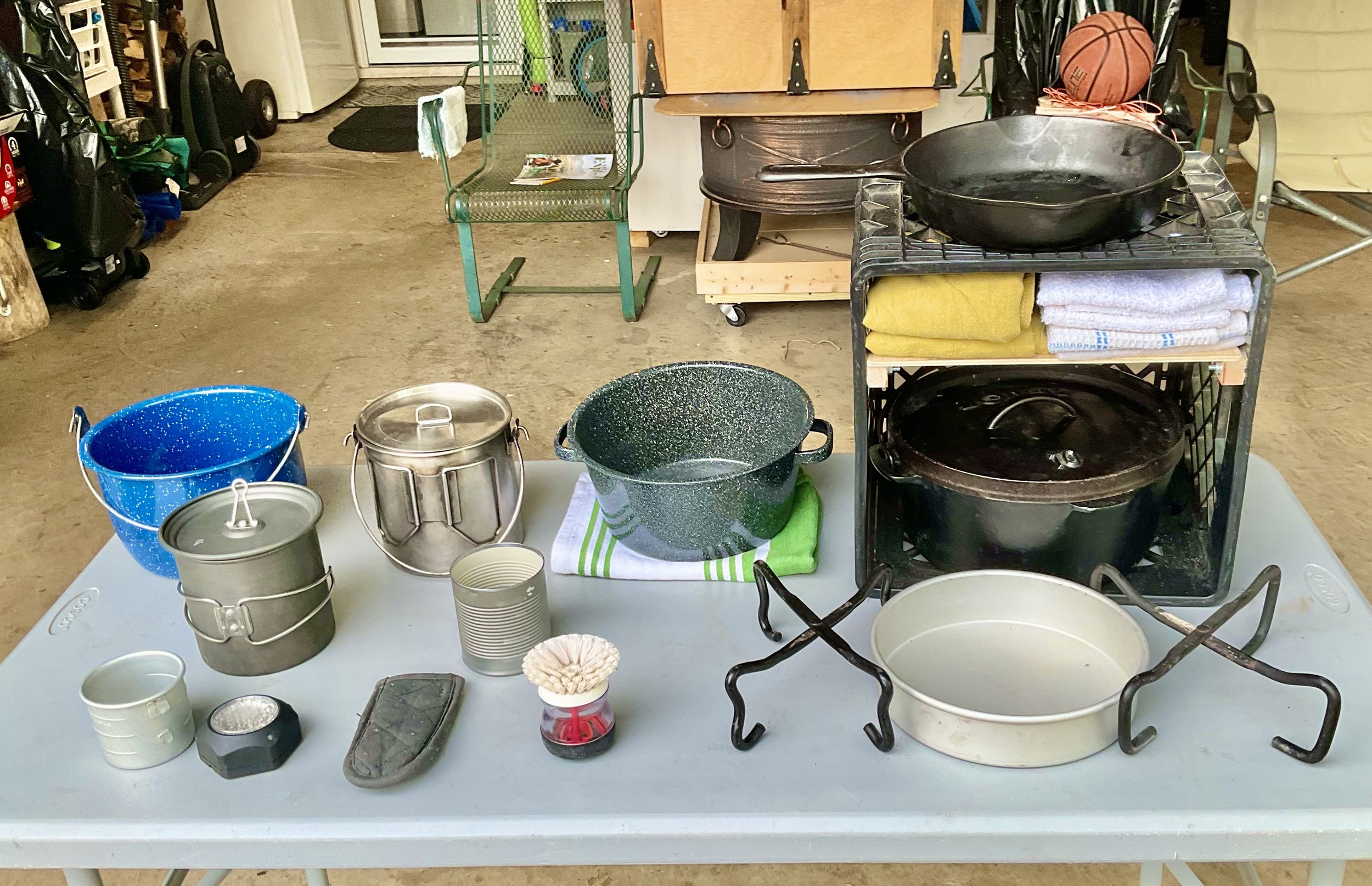Assemble a Kitchen Kit That Will Pack in a Small Space
Camping families will need several different kitchenware items to prepare and eat a wide range of good tasting meals - and these kitchenware items should be small enough to pack into a relatively small space. For example, campers will need a knife to cut vegetables, fruit & meats. They will also need other utensils - such as a can opener, measuring cup, and a pair of tongs - to prepare different foods, pots to cook their food, dishes and utensils to eat the food, and supplies to wash kitchen items after meals. Backpacking campers are unable to carry many kitchen items and, thus, have very limited menu options. But family campers, traveling in cars, have more packing space and, thus, can prepare many more menu options. Here is a summary of the kitchenware items we usually pack for our camping trips.
Cooking Utensils
The first kitchen items to pack are the utensils we might need to prepare our meals. In particular, we will pack two medium-sized, sharp kitchen knives (one for me and one for Eva) and use these knives to cut vegetables, fruit, bread, and meats. More detail about the best camp kitchen knives can be found on the CAMP KITCHEN KNIVES page of this web site. After our knives, we add the following items: a small can opener, a measuring cup without a handle that will nest with other cups, a pair of metal tongs, a few wooden cooking spoons and spatulas with shortened handles, a potato peeler, a telescoping fork for cooking hot dogs and marshmallows, a few stubby butane lighters, and a small grater for grating fresh cheese. To organize these utensils, we pack most of them in a small kitchen organizer tray.
Eating Utensils
The second kitchen items to pack are the spoons and forks we will need to eat our meals. Typically, we pack 6 silver plated spoons and 6 forks. We bought these utensils in a flea market but could have bought stainless steel utensils from a discount department store. We prefer metal utensils over plastic and Nylon utensils because metal utensils are stronger and feel better in our mouth. Dinner knives are unnecessary since we have two food prep kitchen knives and our pocket knives. To organize these utensils, we pack them in an empty food packaging can.
Dishes
PLATES & BOWLS: We prefer good quality enameled steel and stainless steel plates and avoid economy-priced plastic dinner plates and salad bowls. We especially like NorPro 9-inch Stainless Steel Pie Pans that can serve as both camp plates and bowls. Good-quality, economically-priced vintage enamelware can be found in many flea markets. Pack six to eight of these plates so you will have extra plates for grandchildren or friends who may join you.
CUPS: We pack several cups to measure ingredients, to mix these ingredients, to hold beverages, and sometimes hold our cereal and soups. We also use a cup to dip water from a large bucket or stock pot. So we have accumulated 5 stainless steel GSI cups, 4 smaller cups, and a recycled aluminum food packaging can. All of these cups have either folding handles or no handles so that we can nest them all together. When packing, we use these cups to hold smaller spice containers and kitchen utensils. We avoid enamelware cups because they typically have protruding handles that prevent nesting with other cups
Pots & Pans
A camp kitchen should have at least one cooking pot and preferably more.
POTS: Most camping families should have a few cooking pots that range in size from 5-quarts down to 1-quart and have folding or detachable handles so they can nest together for packing efficiency. For example, we have a 4-quart enameled steel pot, a 3-quart stainless steel pot, a 2-quart enameled steel pot, and a 1-quart aluminum pot that all nest neatly together. Stainless steel, enameled steel, and cast iron are better than aluminum and titanium because steel pots can be used to simmer foods for long times without scorching, resist bending and warping, clean up easily, and make food taste better.
FRYING PAN: A camp kitchen should also have a good frying pan to cook a wider range of delicious foods such as bacon, Hamburger Helper meals, chicken, fish, pancakes, fried eggs, and grilled cheese sandwiches. We prefer a vintage cast iron frying pan that has a smooth cooking surface and is about 10 inches in diameter. This size is large enough to cook servings for 6 people but yet small enough to easily pack with other kitchen cookware. Many camping families buy Lodge frying pans but we prefer old antique pans that can be found in antique stores. For more information about cast iron frying pans, check the CAST IRON COOKWARE page of this web site. If you don’t want a cast iron pan, buy a stainless steel or carbon steel pan rather than an aluminum pan because stainless and carbon steel will be less likely to warp and make your food taste better than aluminum.
DUTCH OVEN: A Dutch Oven is unnecessary - but having one allows you to cook more food options such as biscuits, cornbread, and cobblers. We use a vintage 5-quart Wagner Dutch oven (with a flat bottom) that we bought in an antique store. For more information, refer to the CAST IRON COOKWARE page of this website. To bake foods, we added a new 10-inch Lodge flat camp oven lid that we bought in a Lodge Factory outlet store. The oven and its lid nests well with our other pots and can be used both as a cooking pot and as a baking oven.
OTHER: Finally, campers will need a few more kitchen items to handle hot pots and pans: 2 or 3 trivets, hot pot holders, pot lifter or small channel lock pliers, and a pair of thick leather gloves
Pack kitchen dishes and utensils in one milk crate.
We cook a lot of meals over a wood fire and frequently use our Pathfinder 2-quart stainless steel bush pot.
Camping Dutch ovens without legs (center and right) are more useful than ovens with legs (left) because ovens without legs can be used over hot coals - and - on any cook stove.
Pack cookware in a second milk crate.
The Coleman two-burner stove is an economically priced stove that is very useful and durable.
We pack kitchen supplies such as paper towels, cotton towels, and aluminum foil in a third milk crate.
Ice Cooler
Camping families will need an ice cooler to preserve perishable foods. I recommend one that holds about 50 quarts, retains ice for at least 3 days, has a dry food basket, and packs into a small space. See the ICE COOLER page of this website for more details.
Food Storage Containers
We use recycled plastic mayonnaise, peanut butter, and juice containers to hold our beans, rice, and other dry goods. We use recycled juice bottles to hold our milk and condiments. And we use two milk crates to hold all of our dry goods, canned goods, and semi-perishable foods. Milk crates are more practical than plastic totes because crates are easy to pack and easy to handle.
Stoves
Before departing on a trip, we must decide how we will cook our meals and then pack the equipment and fuel we will need. For more information, see the CAMP COOKING page of this website.
Dish Washing Supplies
We pack several items to wash and dry our kitchenware after use: A small bottle of dish washing liquid, 1 or 2 cotton wash cloths, a non-metal scrubbing pad, a stiff brush for cleaning cast iron, and 2 or 3 cotton drying towels.
Kitchen Supplies
In a third milk crate, we pack the following kitchen supplies: table leg extenders (4), paper towels, cotton dish towels, extra propane cylinders, non-stick cooking spray, aluminum foil, 1-quart food storage bags, plastic trash bags, tablecloth, extra butane lighters, and apron.
Water Bottles
In addition to cups, a good camp kitchen should have a few water bottles and jugs. Typically, we pack two 3-liter Ocean Spray juice jugs as our large water bottles because they are easy to pack and carry when full. We avoid extra large 5-gallon water containers because they require a lot of packing space, they are heavy to carry from the water spigot back to the campsite, and they are difficult to lift for pouring. In camp, we place one large bottle in our cooking area and the other one in our hand & dish washing areas. In addition, we pack 2 small water bottles for each person for their personal use - one goes with each person during the day and a second bottle stays in our tent for taking medicine. We prefer bottles with wide mouths because they are easier to fill with ice and liquids. Stainless steel bottles are more ecologically friendly and perhaps healthier, but they are expensive. Frequently, we just use recycled Gator-Aid bottles.
Folding Table(s)
Although we could live without folding tables, we try to pack two of them - one to support our stove and one to serve as a food prep/dining/dish washing countertop. We prefer small 4’ by 3’ folding composite tables but they require more packing space than other options. Campers with limited packing space, may want to consider smaller 3’ by 2.5’ folding tables or roll top tables. To make our stove support table more comfortable, we use table leg extenders to raise the table top height to a countertop height of 36 inches. See my YouTube video for instructions. We could use the picnic table that usually comes with every campsite but this table is small and has several limitations as a complete kitchen workspace. And we avoid metal camp kitchen units because they are heavy, require more packing space than a folding table, cannot support as much weight, and are expensive.
Describes our family camping kitchen







